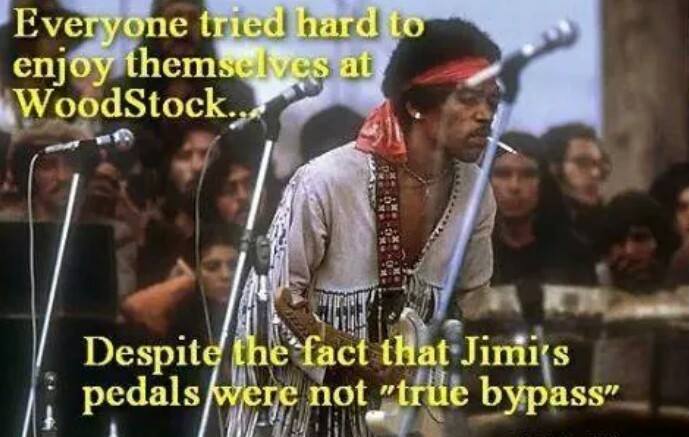Music&Chaos
Well-known member
Final Update:
Discovered that one of my pedals, the G-2 clone, has a buffer in it.
Hello RT,
I recently was doing some experimenting with my pedals and was thrown off.
I was doing some testing and realized that when the pre-amp section of my board will not fully pass signal through when powered off.
I have all true bypass pedals, so this threw me. The signal is there, it is just weak. If I plug power in, my sound goes back to full/normal.
I test my setup all the time with the FX loop pedals left in without power and do not experience this issue.
I need to go through my board and find the specific pedal causing this issue, if it is even really an issue.....more of a curiosity.
I found this post that talks about something similar happening but not quite the same.
I still get sound if they are unpowered, just a thin one, almost like I am hearing the signal being bled off or something.
If power is applied, even if no pedals are on, my full sound returns.
In this person's scenario, they would not get any sound when their pedal did not have power, though it was a true bypass.
"Yup, sounds like a relay true bypass.
I've mentioned this in another post before, but using the 'remove power' method to test for true bypass is a crapshoot at best.
Something like a CryBaby wah with a SPDT switch and an input buffer will still pass signal when unpowered (albeit, the signal being passed won't be buffered). It's still not true bypass. A pedal using a traditional DPDT switch to switch both the signal and ground of the input jack directly to the output jack will also pass signal when unpowered. This is true bypass.
A transistor switching buffered pedal like a Boss pedal won't pass signal when unpowered. It's not true bypass. A relay based true bypass system also may not pass signal when unpowered; however this is still true bypass.
In other words, removing power as a 'test' for true bypass is pretty meaningless; whether a pedal passes signal or not when unpowered has little bearing on the type of bypass, as different methods of both buffered or true bypass may or may not pass signal without power."
When I find the individual pedal in question, it may help further explain the phenomenon.
Discovered that one of my pedals, the G-2 clone, has a buffer in it.
Hello RT,
I recently was doing some experimenting with my pedals and was thrown off.
I was doing some testing and realized that when the pre-amp section of my board will not fully pass signal through when powered off.
I have all true bypass pedals, so this threw me. The signal is there, it is just weak. If I plug power in, my sound goes back to full/normal.
I test my setup all the time with the FX loop pedals left in without power and do not experience this issue.
I need to go through my board and find the specific pedal causing this issue, if it is even really an issue.....more of a curiosity.
I found this post that talks about something similar happening but not quite the same.
I still get sound if they are unpowered, just a thin one, almost like I am hearing the signal being bled off or something.
If power is applied, even if no pedals are on, my full sound returns.
In this person's scenario, they would not get any sound when their pedal did not have power, though it was a true bypass.
"Yup, sounds like a relay true bypass.
I've mentioned this in another post before, but using the 'remove power' method to test for true bypass is a crapshoot at best.
Something like a CryBaby wah with a SPDT switch and an input buffer will still pass signal when unpowered (albeit, the signal being passed won't be buffered). It's still not true bypass. A pedal using a traditional DPDT switch to switch both the signal and ground of the input jack directly to the output jack will also pass signal when unpowered. This is true bypass.
A transistor switching buffered pedal like a Boss pedal won't pass signal when unpowered. It's not true bypass. A relay based true bypass system also may not pass signal when unpowered; however this is still true bypass.
In other words, removing power as a 'test' for true bypass is pretty meaningless; whether a pedal passes signal or not when unpowered has little bearing on the type of bypass, as different methods of both buffered or true bypass may or may not pass signal without power."
When I find the individual pedal in question, it may help further explain the phenomenon.
Last edited:

